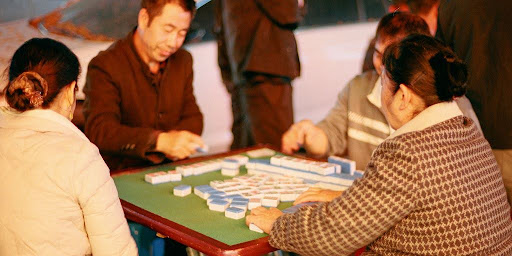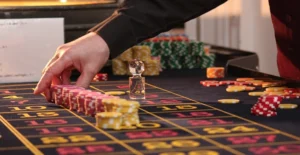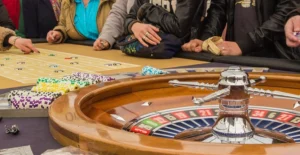Playing baccarat can be exciting, but without a solid plan for your money, even a winning streak can quickly turn into a losing one. This guide focuses on smart baccarat bankroll management tips to help you play longer, make better decisions, and increase your chances of consistent wins. We’ll cover everything from setting your initial budget to knowing when to walk away, all aimed at keeping you in control of your game.
Key Takeaways
- Proper baccarat bankroll management is vital for sustained play and avoiding significant losses.
- Always set a clear budget before playing and stick to it, never betting more than you can afford to lose.
- The 1-5% rule for bet sizing helps preserve your bankroll and allows you to ride out losing streaks.
- Avoiding risky bets, such as the Tie bet, and understanding different betting systems are key to preserving your funds.
- Implementing stop-loss limits and win goals, along with taking regular breaks, are crucial for maintaining discipline and preventing impulsive decisions.
What Is Baccarat Bankroll Management and Why It Matters

Alright, let’s talk about keeping your money safe while playing baccarat. Bankroll management is a plan for how you’re going to handle the money you set aside for gambling. It’s not just about having cash; it’s about being smart with it so you can actually play for a while and, hopefully, have some fun without going broke. Think of it like setting a budget for a trip – you decide how much you can spend before you even leave home.
Why It Matters
So, why is this whole bankroll thing such a big deal? It’s important if you want to keep playing baccarat without ending up in a bad spot. Without a plan, it’s easy to get caught up in the game and spend more than you intended. This can lead to making rash decisions, like trying to win back money you just lost by betting bigger amounts, which usually just makes things worse. Good bankroll management helps you avoid those costly mistakes and keeps the game enjoyable. It’s about playing responsibly and making sure that a few unlucky hands don’t ruin your entire gaming budget.
Here’s a quick look at why it’s so key:
- Prevents Overspending: It sets clear limits, so you know exactly how much you can afford to lose.
- Extends Playtime: By betting smaller amounts, you can play more hands and enjoy the game longer.
- Reduces Emotional Decisions: When you’re not stressed about losing money, you’re less likely to make impulsive bets.
- Supports Consistent Play: It allows you to stick to a strategy without being forced to change it due to a depleted bankroll.
Many players focus too much on game strategies and forget about the money side of things. But really, how you manage your funds is just as important, if not more so, than knowing the rules of baccarat. It’s the foundation for a good gaming experience.
When you’re starting, it’s a good idea to figure out how much you’re comfortable setting aside for baccarat. This amount should be money you can afford to lose without it impacting your daily life or bills. For instance, if you decide to budget $500 for your baccarat sessions, that’s your bankroll. You then need a plan for how you’ll use that $500. This might involve deciding on a bet size that’s a small percentage of your total bankroll, like the 1-5% rule we’ll discuss later. This approach helps ensure that even if you hit a losing streak, you won’t burn through your entire bankroll in just a few bets.
Setting a Realistic Baccarat Budget: How Much Should You Start With?
When you sit down to play baccarat, the first thing you need to figure out is how much money you’re going to use for playing. This isn’t just about picking a number; it’s about being smart and realistic so you can enjoy the game without causing yourself financial stress. Think of it like setting a budget for a night out – you decide how much you’re willing to spend on dinner, drinks, and maybe a movie, and you stick to it. Your baccarat budget should be treated the same way. It’s money set aside purely for entertainment, meaning it’s cash you can afford to lose without it impacting your rent, bills, or savings. A good starting point is to consider what you’d normally spend on other forms of entertainment, like going to the movies or dining out.
Setting Your Limits
It’s a good idea to decide if you want to set a weekly or monthly budget. If you get paid monthly, a monthly budget might seem natural. However, if you find yourself tempted to spend it all at once, breaking it down into weekly amounts can help you stay disciplined. Some players even find it useful to separate their gambling money from their main bank account. You could set up a separate savings pot or transfer your weekly budget directly into your casino account at the start of the week. This way, you’re less likely to dip into funds meant for other things.
- Determine your entertainment budget: How much do you spend on other leisure activities? Use this as a baseline.
- Choose a timeframe: Will you budget weekly or monthly?
- Separate your funds: Keep your gambling money distinct from your everyday finances.
How Much to Start With?
There’s no single magic number for everyone, as it depends entirely on your financial situation and comfort level. However, a common guideline is to ensure that your bet size represents a very small percentage of your total bankroll. For baccarat, which is generally considered a lower variance game compared to slots or roulette, betting up to 5% of your bankroll per hand is often suggested. This means if you have a $100 bankroll, you might be looking at bets of $5 or less per hand. This approach helps you play for longer and gives you a better chance to ride out any short-term losing streaks. Remember, the goal is to extend your playing time and enjoy the game, not to risk a significant portion of your funds in a single session. It’s about making your entertainment budget last.
The key is to set a budget when you’re feeling calm and rational, not when you’re already excited or frustrated by the game. This prevents emotional decisions that can quickly deplete your funds.
Budgeting for Sessions
Once you have your total budget, it’s wise to divide it further for each playing session. For example, if your weekly budget is $100 and you plan to play three times a week, you might allocate about $33 per session. This prevents you from blowing your entire weekly budget in one go. If you have a particularly good or bad session, you know you have other opportunities to play later in the week without exceeding your overall limit. This structured approach is a cornerstone of smart bankroll management, helping you maintain control and make informed decisions throughout your gaming experience. It’s also worth noting that understanding the odds, like the slightly better chance of the banker winning, can inform your betting choices, but always remember the commission on banker wins. You can find more about baccarat betting odds to help with this. Ultimately, consistent management is more important than the exact amount you start with.
The 1–5% Rule: Optimal Bet Sizing for Long-Term Play
When you’re playing baccarat, keeping your money safe is important. A good way to do this is by setting limits on how much you’ll bet each round. This is where the 1-5% rule comes in handy. It’s a simple idea: you should only bet between 1% and 5% of your total bankroll on any single bet. This helps you play longer and gives you a better chance to handle those inevitable losing streaks without going broke too fast.
Why the 1-5% Rule Matters
Think about it like this: if you have $1000 set aside for playing baccarat, the 1-5% rule means you’d be betting between $10 and $50 per hand. Betting too much, like $100 a hand, means you could lose your entire bankroll in just ten bad hands. That’s no fun. By keeping your bets small, you give yourself more chances to win and more time to enjoy the game. It’s a smart way to make sure your money lasts, especially since baccarat can have its ups and downs, just like any casino game. You can find more info on game volatility at Nixbet to help you pick games that fit your budget.
How to Calculate Your Bet Size
So, how do you figure out your bet size? It’s pretty straightforward. First, decide on your total bankroll for your baccarat sessions. Let’s say you’ve decided to budget $500 for the month. If you plan to play once a week, that’s $125 per session. Now, apply the 1-5% rule to that session bankroll. If you’re feeling conservative, you might bet 1% of $125, which is $1.25 per hand. If you’re a bit more comfortable with risk, you could go up to 5%, which is $6.25 per hand. The exact percentage you choose depends on how much risk you’re okay with and how long you want your money to last. For games like baccarat, which have a lower house edge compared to some other casino games, betting closer to the 3-5% range might be acceptable for some players, but starting lower is always a good idea.
Factors Influencing Your Bet Size
Several things can affect where you fall within that 1-5% range:
- Game Volatility: Baccarat is generally considered a lower-volatility game compared to something like slots. This means your wins and losses tend to be more consistent, allowing for slightly larger bets within the 1-5% range.
- Your Risk Tolerance: Are you someone who likes a bit more excitement and is okay with bigger swings, or do you prefer a steadier, more predictable experience? Your comfort level with risk should guide your bet sizing.
- Session Goals: If you’re aiming for a specific profit target or just want to play for a long time, adjust your bet size accordingly. Smaller bets are better for longer play, while slightly larger bets might help you reach a profit goal faster, but with more risk.
Remember, the goal is to make your bankroll last. It’s better to have a few smaller wins over time than to risk it all on one big bet and lose everything. Consistency is key to long-term play.
Adjusting Your Strategy Over Time
It’s also smart to keep track of your results. If you notice you’re consistently losing more than you’re winning, even with the 1-5% rule, you might need to adjust your bet size down or even take a break from the game. On the flip side, if you’re on a winning streak and feeling confident, you might stick to your plan or slightly increase your bet size, but always stay within your chosen percentage. This flexible approach helps you adapt to the game’s flow and protect your bankroll. Understanding the odds, like the house edge on banker bets, is also part of smart betting in baccarat.
Avoiding the Tie Bet: Preserving Your Bankroll Wisely
The Allure and Danger of the Tie Bet
The Tie bet in baccarat might seem tempting with its higher payout, often 8-to-1. However, this bet carries a significantly higher house edge compared to the Banker or Player bets. For instance, while the Banker bet typically has a house edge of around 1.06% (after commission), and the Player bet around 1.24%, the Tie bet can hover around 14.4% or even higher, depending on the casino’s specific rules. This makes it a bankroll drain over the long run.
Why Avoiding the Tie Bet Preserves Your Funds
Sticking to the Banker or Player bets is a cornerstone of smart baccarat bankroll management. By consistently avoiding the Tie bet, you are actively choosing wagers with better odds, which directly translates to preserving your capital for longer playing sessions. It’s a simple yet powerful way to reduce the house’s advantage and give yourself a better chance to weather variance.
Here’s a quick look at the typical house edges:
| Bet | Typical House Edge |
| Banker | ~1.06% |
| Player | ~1.24% |
| Tie | ~14.4% or higher |
Practical Application for Players
When you sit down at the baccarat table, make a conscious decision to ignore the Tie bet. Focus your wagers solely on the Banker or Player positions. This discipline is key. It’s easy to get swayed by a large payout, but remember that consistency in your betting choices is what helps protect your bankroll. Think of it as a simple rule: if it’s a Tie bet, you don’t place it. This approach aligns with sound bankroll management principles, helping you to play baccarat smarter.
Consistently choosing bets with lower house edges is a fundamental aspect of preserving your bankroll. While the allure of a high-payout Tie bet is understandable, its statistical disadvantage makes it a poor choice for disciplined players aiming for longevity at the table.
Flat Betting vs. Progressive Systems: Which Is Right for You?
When you’re playing baccarat, you’ll come across two main types of betting systems: flat betting and progressive systems. Understanding the difference and which might suit your playstyle is pretty important for managing your bankroll.
Flat Betting
Flat betting is the simplest approach. You bet the same amount on every hand, no matter if you win or lose the previous one. It’s straightforward and doesn’t try to chase losses or capitalize on wins by changing your bet size. This method is great for keeping your betting consistent and predictable. It helps you stick to your budget because your bet amount never changes, making it easier to track your spending over time. This consistency is key for long-term play.
Progressive Betting Systems
Progressive systems, on the other hand, involve changing your bet size based on the outcome of previous hands. There are two main types:
- Negative Progression: In these systems, you increase your bet after a loss. The idea is that eventually, you’ll win, and that win will cover all your previous losses plus a profit. The Martingale system, where you double your bet after each loss, is a classic example. While it sounds good on paper, it can quickly lead to very large bets, especially if you hit a losing streak. You also need to be aware of table limits. You can read more about how these systems work on Wizard of Odds.
- Positive Progression: These systems involve increasing your bet after a win. The Paroli system is a good example, where you might double your bet after a win, aiming to capitalize on winning streaks. The idea here is to make small, consistent bets during losing periods and then increase bets when you’re on a roll. This can feel less risky than negative progression systems because you’re only increasing bets when you’re already winning.
Which System Is Right for You?
Choosing between flat betting and a progressive system depends on your personal preference, your risk tolerance, and your bankroll size. If you prefer a steady, predictable approach and want to minimize the risk of big swings, flat betting is likely your best bet. It’s a low-risk method that helps you play longer. If you’re comfortable with more volatility and want to try and maximize wins during streaks, a positive progressive system like Paroli might be more appealing. Negative progression systems, like Martingale, are generally considered riskier and require a larger bankroll to withstand potential losing streaks. It’s always a good idea to test any system with smaller bets before committing significant funds.
Mastering the Martingale and Paroli Strategies Safely
When you’re looking to add some structure to your baccarat play, the Martingale and Paroli systems are two popular betting strategies that often come up. They’re quite different in how they approach wins and losses, so understanding them is key to deciding if they fit your style.
The Martingale System: Doubling Down on Losses
The Martingale system is a negative progression strategy. The core idea is simple: after every loss, you double your bet. The theory is that eventually, you’ll win a hand, and that single win will cover all your previous losses, plus give you a profit equal to your original bet. After a win, you return to your starting bet amount. It sounds good on paper, especially if you hit a winning streak, but it comes with significant risks. A long losing streak, which can happen in baccarat, can quickly escalate your bets to very high amounts, potentially exceeding table limits or draining your bankroll faster than you expect. It’s vital to have a substantial bankroll if you plan to use this method.
Here’s a quick look at how it works:
- Start with a base bet (e.g., $10).
- If you win, bet $10 again.
- If you lose, double your bet to $20.
- If you lose again, double it to $40.
- Continue doubling after each loss until you win.
- Once you win, go back to your base bet of $10.
The Paroli System: Riding the Winning Streak
In contrast, the Paroli system, sometimes called the reverse Martingale, is a positive progression strategy. This means you increase your bet after a win, not a loss. The goal is to capitalize on winning streaks. Typically, players aim for three consecutive wins, doubling their bet each time. After the third win, or if they lose at any point, they return to their original base bet. This system is generally considered less risky than the Martingale because you’re only increasing bets when you’re winning, and the amount risked on any single progression is limited. It’s a good way to try and maximize profits during a hot streak without the same rapid escalation of bets seen in the Martingale. Many players find this approach more aligned with a consistent betting approach.
Here’s a typical Paroli progression:
- Start with a base bet (e.g., $10).
- If you win, double your bet to $20.
- If you win again, double it to $40.
- If you win a third time, you’ve completed a cycle. Return to your base bet of $10.
- If you lose at any point, return to your base bet of $10.
Both systems require discipline. The Martingale can be dangerous if you hit a long losing streak, while the Paroli can be frustrating if you can’t string together wins. It’s important to set limits and stick to them, regardless of which system you choose.
Implementing the Golden Eagle Strategy: A Balanced Approach
The Golden Eagle strategy is a bit different from some of the more aggressive betting systems out there. It’s designed to be a more measured approach, aiming for steady progress rather than wild swings. Developed by a mathematician named Ri Chang, this method involves switching between two distinct playing styles. It’s all about finding a rhythm that works with the flow of the game.
The Core Mechanics of the Golden Eagle
The strategy essentially has two modes: a conservative betting pattern and a more aggressive one. You start with a base unit, which should be a small percentage of your total bankroll, maybe 1% or 2%. The idea is to build up slowly.
Here’s a simplified look at how it might play out:
- Mode 1 (Conservative): You’ll typically bet one unit on the Banker or Player. If you win, you stay at one unit. If you lose, you also stay at one unit. This mode is about preserving your bankroll and grinding out small wins.
- Mode 2 (Aggressive): This mode kicks in after a certain number of wins or when you hit a specific profit target within a session. Here, you might increase your bet size, perhaps to two or three units, to capitalize on winning streaks. However, the strategy has built-in rules for when to switch back to the conservative mode to protect your gains.
When to Use Which Mode
Deciding when to switch gears is key. The Golden Eagle strategy provides guidelines for this transition. Generally, you’ll move to the more aggressive mode after a few consecutive wins, aiming to push your advantage. Conversely, a loss or a series of losses will prompt a return to the conservative mode. This adaptability is what makes it a balanced approach.
The goal is to ride winning streaks with slightly larger bets while minimizing risk during losing periods by sticking to smaller wagers. It’s a way to manage variance without completely abandoning the pursuit of profit.
Adapting the Golden Eagle
While the core principles are set, you can adjust the unit size and the triggers for switching modes to fit your personal risk tolerance. For instance, some players might use a larger base unit or switch to aggressive mode after more wins. It’s important to understand the underlying mathematics of the Golden Eagle Baccarat Strategy to make informed adjustments. Remember, consistency in applying the chosen parameters is more important than the specific numbers you pick. Always ensure your chosen unit size is sustainable for your bankroll.
Setting Stop-Loss and Win Goals: Knowing When to Walk Away

Part of playing smart is knowing when to call it a day, whether you’re ahead or behind. Setting clear limits before you even start playing is a really solid move. It’s like having a game plan for your money, so you don’t get caught up in the moment and make decisions you’ll regret later.
Define Your Win Goal
Decide on a target profit for your session. This isn’t about winning every single hand, but rather reaching a specific profit amount. For example, you might aim to increase your starting bankroll by 20%. Once you hit that number, it’s time to cash out and enjoy your winnings. This helps prevent overconfidence from creeping in and making you play longer than you should.
Establish Your Stop-Loss Limit
This is just as important. A stop-loss limit is the maximum amount you’re willing to lose in a single session. If you reach this predetermined loss amount, you must stop playing immediately. This protects your overall bankroll from significant damage during a losing streak. A common approach is to set this at 20-30% of your session bankroll.
The Importance of Regular Breaks
Even with clear goals, playing for too long can lead to fatigue and poor decision-making. Taking short breaks every hour or so can help you stay sharp and objective. It gives you a chance to clear your head and reassess your strategy. Remember, baccarat is a game of chance, and staying focused is key to managing your bankroll effectively. It’s easy to get caught up in the action, but stepping away for a few minutes can make a big difference in the long run. Think of it as a way to reset your mental game, much like how athletes take timeouts during a match. This discipline is what separates casual players from those who manage their money well over time.
Discipline in setting and adhering to these limits is paramount. It’s the difference between a controlled gaming experience and one that can quickly spiral out of control. Treat these limits as non-negotiable boundaries for your session.
Example Session Limits
Here’s a simple way to visualize these limits:
- Starting Bankroll: $500
- Win Goal (20%): $100 (Target: $600)
- Stop-Loss Limit (25%): $125 (Maximum loss: $375)
If you reach $600, you walk away with a profit. If your bankroll drops to $375, you stop playing for that session. This structured approach helps maintain control and protects your overall funds, allowing for more consistent play over time. It’s about playing the game, not letting the game play you. For more on managing your funds, consider looking into blackjack tournament strategy, as similar principles apply to bankroll control.
Session Management: The Power of Taking Regular Breaks
When you’re playing Baccarat, it’s easy to get caught up in the action. Hours can fly by, especially if you’re on a winning streak. But staying glued to the table for too long can hurt your game. Your focus starts to fade, you might make rash decisions, and before you know it, you’ve lost some of those hard-earned winnings. That’s where session management comes in. It’s all about taking smart breaks to keep your head in the game.
Why Breaks Matter
Think of it like this: even the sharpest minds need a rest. Playing Baccarat, even with a solid bankroll management plan, requires constant attention. Without breaks, you risk:
- Decision Fatigue: Making poorer choices as the session wears on.
- Emotional Swings: Letting wins or losses dictate your betting without a clear strategy.
- Loss of Focus: Missing important game details or betting incorrectly.
Taking a break, even for just 10-15 minutes every hour or so, can make a huge difference. It gives you a chance to clear your head, reassess your strategy, and return to the table with renewed concentration. It’s a simple yet effective way to protect your bankroll and improve your overall performance. Remember, playing smart isn’t just about betting; it’s also about knowing when to step away for a moment.
How to Structure Your Breaks
There’s no one-size-fits-all approach to taking breaks, but here are some ideas to get you started:
- Time-Based Breaks: Set a timer for every 45-60 minutes of play. When it goes off, step away for at least 10 minutes. This is a straightforward way to build breaks into your routine.
- Win/Loss Triggered Breaks: If you hit a significant win or experience a substantial loss, consider taking a short break. This allows you to process the outcome emotionally before deciding on your next move. It helps prevent chasing losses or getting too cocky after a big win.
- Activity-Based Breaks: Use your break time to do something completely different. Grab a drink, walk around, or chat with someone. This mental reset is key to returning with a fresh perspective.
It’s also a good idea to have a plan for what you’ll do after your break. Will you stick to your original betting strategy, or will you adjust based on how you’re feeling? Having a clear plan helps maintain discipline. For instance, if you’ve been playing for a while and are up, you might decide to reduce your bet size slightly during the next session, even if you’re feeling good. This is a smart move to protect your profits. You can find more tips on managing your money at Money Drop casino.
The goal of session management is not to avoid playing, but to play more effectively and sustainably. By incorporating regular breaks, you’re actively working to preserve your bankroll and make more rational decisions throughout your gaming experience.
Tracking Your Performance: Using Units to Monitor Progress
Keeping tabs on how you’re doing in baccarat is pretty important if you want to win more often. It’s not just about the hands you play, but also about understanding your performance over time. Think of it like tracking your fitness – you wouldn’t just go to the gym without knowing if you’re getting stronger, right? The same idea applies here.
Using Units for Tracking
One of the best ways to keep track is by using “units.” A unit is simply a fixed amount of your bankroll that you decide on beforehand. For example, if your total bankroll is $1,000, you might decide that one unit is $10. This means your standard bet would be one unit, or $10. If you have a winning streak and your bankroll grows to $1,200, your unit size might stay at $10, or you could adjust it to $12 if you prefer to keep the same percentage of your bankroll per bet. This unit system helps you standardize your betting and makes it easier to see your progress in percentage terms.
Here’s a simple way to track your sessions:
- Date: When you played.
- Starting Bankroll: How much money you had at the start of the session.
- Units Bet: The total amount you wagered during the session, measured in your defined units.
- Net Win/Loss: The difference between your starting and ending bankroll for that session.
- Ending Bankroll: How much money you had when you finished playing.
It’s also a good idea to note down the game variant or any specific strategies you were using. This extra detail can help you spot what’s working and what isn’t.
Keeping records isn’t about dwelling on losses; it’s about learning from every session. Whether you win or lose, understanding the ‘why’ behind the outcome is what truly helps you improve your game and manage your money better. It’s about making informed decisions for the future, not just reacting in the moment.
Looking at your performance over several sessions can reveal patterns. Maybe you tend to play better in the morning, or perhaps a certain betting system seems to yield better results for you. You can find more tips on managing your bankroll at Bingo Cash.
Analyzing Your Performance Data
Once you have a few sessions recorded, you can start to analyze them. A simple spreadsheet is perfect for this. You can calculate:
- Average Bet Size (in units): Helps you see if you’re sticking to your plan.
- Win Rate per Session: How often you end a session with more money than you started with.
- Total Profit/Loss over Time: The overall picture of your bankroll’s health.
- Average Session Length: Useful for understanding how long your money typically lasts.
By regularly reviewing this data, you can make smarter adjustments to your betting strategy and bankroll management plan, helping you stay in the game longer and potentially see more consistent wins.
Leveraging Casino Bonuses to Boost Your Bankroll
Understanding Bonus Terms and Conditions
Casino bonuses can give your bankroll a nice boost, but you have to be smart about them. It’s not just about grabbing the biggest number; you need to look closely at what’s required. Most bonuses come with what are called ‘wagering requirements.’ This means you have to bet the bonus amount a certain number of times before you can cash out any winnings. For example, a 30x wagering requirement on a $100 bonus means you need to wager $3,000 before you can withdraw. Always read the fine print. Some bonuses might look great on the surface, but the terms can make them less appealing.
Types of Bonuses to Consider
When you’re looking to add to your Baccarat funds, keep an eye out for a few specific types of offers:
- Welcome Bonuses: These are usually offered to new players when they first sign up and make a deposit. They often match a percentage of your deposit.
- Reload Bonuses: Similar to welcome bonuses, but offered to existing players when they make subsequent deposits.
- Cashback Offers: Some casinos give you a percentage of your losses back over a certain period. This can help cushion a losing streak.
- No-Deposit Bonuses: Less common, but these give you a small amount of bonus money just for signing up, without needing to deposit anything first.
Maximizing Bonus Value
To make these bonuses work for your Baccarat bankroll, think about how they fit into your overall strategy. A bonus is most effective when it aligns with your planned betting patterns and doesn’t encourage you to play outside your budget. If a bonus has very high wagering requirements, it might be better to skip it and stick to playing with your funds. Always compare offers from different casinos to find the ones that provide the best value for your play style. You can often find good deals by checking out casino reviews.
It’s easy to get excited by bonus offers, but remember, they are a tool to extend your playing time and potentially increase your winnings, not a guaranteed profit. Treat them as an added benefit to your bankroll, not a replacement for sound bankroll management.
Practicing Responsible Gambling: Staying in Control
Responsible gambling is all about keeping things fun and under control. It means setting limits before you even start playing and sticking to them, no matter what. Think of your gambling money as entertainment funds, separate from your everyday bills and savings. If you’re playing baccarat, it’s easy to get caught up in the action, especially if you’re on a winning streak or trying to make back some losses. But that’s exactly when you need to be extra careful.
Setting Boundaries
- Decide on a budget: Before you sit down to play, determine exactly how much you can afford to lose. This amount should be money you don’t need for anything else. It’s your entertainment allowance.
- Time limits: Set a timer for your gaming sessions. When the timer goes off, you stop playing, win or lose. This prevents marathon sessions that can lead to fatigue and poor decisions.
- Win and loss limits: Decide beforehand how much you’d be happy to win and how much you’re willing to lose. If you hit either of those numbers, it’s time to call it a day. This is a key part of effective baccarat bankroll management.
Recognizing Problematic Behavior
It’s important to be honest with yourself about your habits. Some signs that you might be moving beyond casual play include:
- Chasing losses: Trying to win back money you’ve lost by betting more or playing more frequently.
- Gambling with essential funds: Using money meant for rent, bills, or groceries.
- Secrecy: Hiding your gambling activity from friends or family.
- Restlessness: Feeling agitated or irritable when you can’t play.
If any of these sound familiar, it might be time to take a break or seek support. Many casinos offer tools to help you manage your play, like deposit limits and self-exclusion options. Using these resources is a sign of strength, not weakness. Remember, the goal is to enjoy the game without letting it negatively impact your life. Staying in control means knowing when to walk away, even when things are going well. You can find more information on responsible play at gambling support sites.
Frequently Asked Questions
What is baccarat bankroll management, and why is it important?
Bankroll management in baccarat is like having a game plan for your money. It means deciding how much you can afford to lose before you start playing and sticking to that limit. This helps you play longer and avoid losing more than you can handle.
How much money should I set aside for baccarat?
You should set aside an amount of money that you are comfortable losing. Never use money meant for bills or essential living expenses. A good starting point is to determine how much you can afford to play with for a specific period, like a month.
What is the 1-5% rule for betting?
It’s wise to bet only a small portion of your total bankroll on each hand, typically between 1% and 5%. This way, even if you lose several hands in a row, you won’t run out of money too quickly.
Why should I avoid betting on ties in baccarat?
The tie bet in baccarat usually has a higher house edge, meaning it’s less likely to pay off in the long run. By avoiding this bet, you can keep more of your money and increase your chances of winning over time.
What’s the difference between flat betting and progressive systems?
Flat betting means you bet the same amount each hand. Progressive systems involve changing your bet size based on wins or losses. Flat betting is simpler and less risky, while progressive systems can potentially increase winnings during hot streaks but also carry more risk.
How do Martingale and Paroli strategies work safely?
The Martingale strategy involves doubling your bet after every loss to try and win back your losses. The Paroli system involves doubling your bet after every win. Both can be risky if you hit a long losing or winning streak.
What is the Golden Eagle strategy in baccarat?
The Golden Eagle strategy is a balanced approach that involves betting a certain number of units and adjusting your bets based on wins and losses. It aims to protect your bankroll while still allowing for potential gains.
Why are stop-loss and win goals important?
Setting a stop-loss limit means deciding the maximum amount you’re willing to lose in a session. A winning goal is deciding how much you want to win before you stop playing. Both help you quit while you’re ahead or cut your losses.
Daniel Chase is a seasoned casino analyst and iGaming writer with over 10 years of experience in the online gambling industry. He specializes in game strategy, casino odds, and player-focused reviews. Daniel is passionate about helping players make smarter decisions through transparency, real data, and honest insight.











